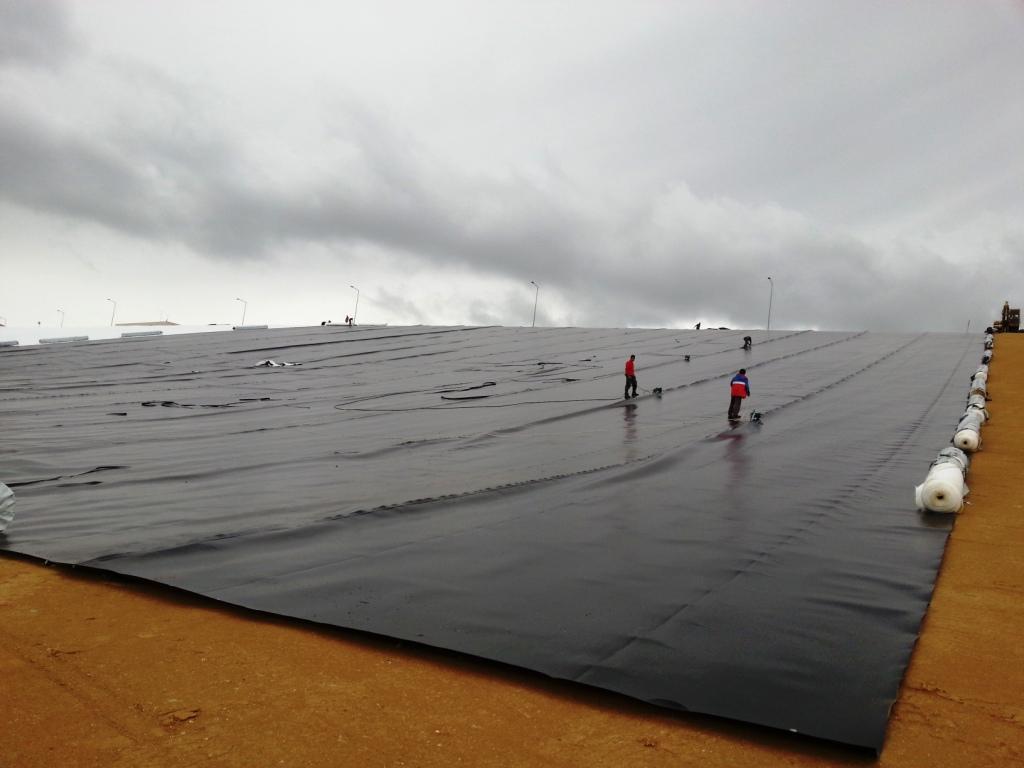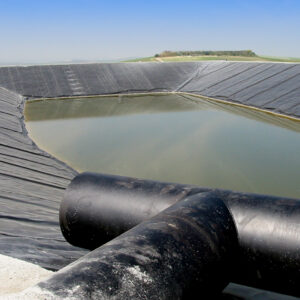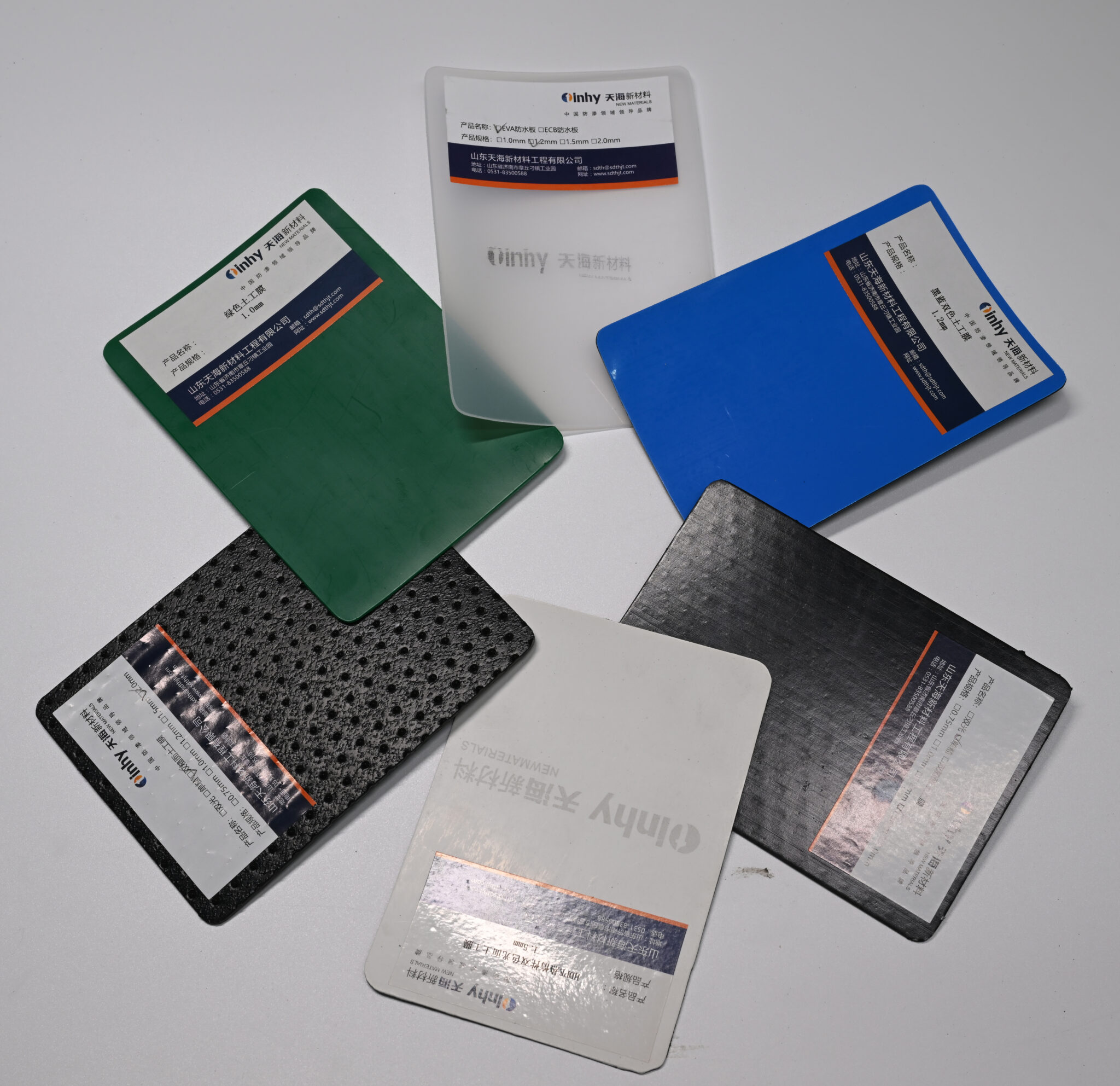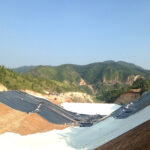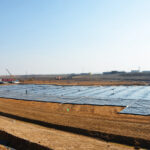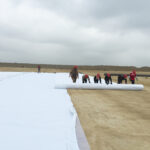What is a geomembrane?
Geomembrane is a thin film made of polymer materials, mainly used in civil engineering and environmental engineering to prevent the penetration of moisture, chemicals or other harmful substances, while providing soil stability and protection of engineering structures.
Such films are typically produced by extrusion, stretching, extrusion, coextrusion or other processes.
The main characteristics of geomembranes include:
Waterproofing: One of the main functions of geomembrane is waterproofing. It can be used to prevent moisture from penetrating from the soil into structures or underground spaces, thereby preventing foundation settlement, soil erosion and other problems.
Barrier properties: Geomembranes can also be used to prevent chemicals, harmful gases or waste from penetrating into the soil, thereby protecting the environment from pollution.
Anti-permeability: Geomembranes usually have good anti-permeability properties and can prevent moisture in the soil from penetrating to a certain extent.
Anti-aging: In order to ensure long-term use, geomembranes usually have anti-ultraviolet and anti-oxidation properties to slow down the aging process of the material.
Tensile strength: The geomembrane needs to have a certain tensile strength to adapt to the possible stretching and extrusion forces in the project.
Flexibility: Geomembranes often need to have some flexibility to adapt to irregular terrain or structures.
Chemical stability: Geomembranes need to remain stable in different chemical environments and not be corroded by chemical substances.
Water Permeability: In some applications, a geomembrane may need to be water permeable to allow the passage of moisture but prevent the penetration of particulate matter.
Geomembranes are widely used in fields such as water conservancy projects, road projects, environmental projects, landscaping, mining and sewage treatment. Different types of geomembranes, such as HDPE (high-density polyethylene), LDPE (low-density polyethylene), PVC (polyvinyl chloride), etc., can be selected according to specific engineering needs.

The role of geomembrane
Geomembranes play a variety of important roles in civil and environmental engineering, mainly due to their waterproofing, isolation and protection properties. Here are some of the main functions of geomembranes:
Waterproofing: One of the primary functions of geomembranes is to provide a waterproof barrier. It prevents groundwater or rainfall water from penetrating into the soil, thereby protecting underground structures, foundations or engineering sites from water damage. This is very important to prevent foundation settlement and maintain structural stability.
Isolation: Geomembranes can isolate the penetration of moisture, chemicals or harmful substances between different strata. It can prevent the mutual penetration of groundwater and soil containing harmful substances, thereby preventing environmental pollution.
Soil stability: Geomembrane can improve the stability of soil and reduce soil erosion and loosening. This is of great significance for maintaining roads, slope protections, berms, etc. in civil engineering.
Chemical protection: Geomembranes can provide a barrier to chemicals in the soil and prevent harmful substances from seeping into groundwater, thereby protecting water quality and the environment.
Prevent foundation settlement: In some underground projects, the use of geomembranes can effectively reduce the risk of foundation settlement. By preventing water penetration, geomembranes slow down the soil’s settling process.
Anti-penetration: Geomembrane has a certain degree of anti-permeability, which can prevent water penetration in the soil to a certain extent and prevent water loss from the soil.
Maintain the project structure: Geomembrane can provide protection for underground structures and extend the life of the project. It can reduce soil erosion of structures and maintain structural integrity.
Environmental protection applications: In environmental engineering, geomembranes can be used in landfills, oil pollution treatment sites, etc. to prevent harmful substances from penetrating into soil and water and play an environmental role.
Overall, geomembranes play an important role in waterproofing, isolation, protection and environmental protection in engineering practice, providing reliable technical solutions for various civil engineering projects.
What types of geomembranes are there?
Geomembranes can be divided into many different types according to their materials and preparation methods. Here are some common geomembrane types:
HDPE geomembrane (high-density polyethylene geomembrane): HDPE geomembrane is made of high-density polyethylene and has good mechanical strength and anti-aging properties. It is widely used in waterproofing, isolation and environmental protection, and is suitable for road engineering, water conservancy projects and other fields.
LDPE geomembrane (low density polyethylene geomembrane): LDPE geomembrane has good flexibility and water permeability, and is suitable for some projects that require water permeability, such as pond lining, wetland protection, etc.
LLDPE geomembrane (linear low density polyethylene geomembrane): LLDPE geomembrane is a type of geomembrane between HDPE and LDPE. It has good tensile properties and wear resistance and is suitable for some bending geomembranes. Projects with performance requirements.
PVC geomembrane (polyvinyl chloride geomembrane): PVC geomembrane has good chemical corrosion resistance and is widely used in waterproofing, sewage treatment, sewage sedimentation tank and other projects. It can also be used as the lining material of sedimentation tank or storage tank.
EVA geomembrane (ethylene-vinyl acetate copolymer geomembrane): EVA geomembrane usually has good flexibility and impact resistance, and is suitable for some environments that require high cold resistance, such as projects in cold areas.
Composite geomembrane: Composite geomembrane is made by laminating multiple layers of films of different materials to combine the advantages of various materials. This can include composites such as HDPE and nonwovens, HDPE and acrylic waterproofing membranes to provide more diverse performance.
Geogrid membrane: Geogrid membrane is a geomembrane with an open hole structure that can be used in soil reinforcement, slope protection, bank protection and other projects to provide structural support for the soil and water flow guidance.
The above are some common geomembrane types. Choosing the appropriate geomembrane type usually depends on the requirements of the specific project, environmental conditions and the performance characteristics of the geomembrane.

